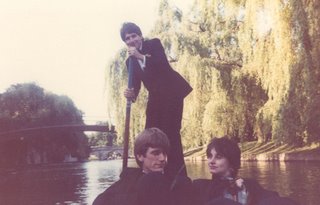
Some people had a question as to what is punting. This is Newton before being a Dr., punting (or being punted?) in 1980.
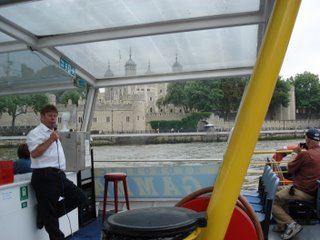 And then there was one. The last full day of the program in Britain, and the last full day in London. Both the English literature group and the history group set off from the Embankment down the River Thames to Greenwich. London was important because it was on an important waterway, and, while we saw sites such as the Tower of London (in the background, here), it was really the docklands to the East of the Tower (the East End) that was most important for our purposes.
And then there was one. The last full day of the program in Britain, and the last full day in London. Both the English literature group and the history group set off from the Embankment down the River Thames to Greenwich. London was important because it was on an important waterway, and, while we saw sites such as the Tower of London (in the background, here), it was really the docklands to the East of the Tower (the East End) that was most important for our purposes.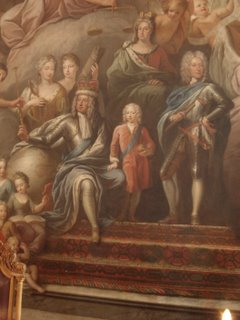 Next time, you really ought to poke your head in there. Walls and ceilings are all upholding the Glorious Revolution by focusing on William and Mary. I also visited and ate at Goddard's Pie and Eel shop (although I didn't have eels), while most of you had TexMex food.
Next time, you really ought to poke your head in there. Walls and ceilings are all upholding the Glorious Revolution by focusing on William and Mary. I also visited and ate at Goddard's Pie and Eel shop (although I didn't have eels), while most of you had TexMex food. 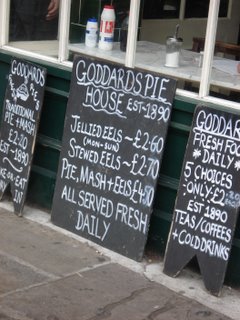 It is one of the last of a kind serving more traditional East End working class hot lunches, but I thought I might have trouble convincing you of the joys of meat pie, mash, and mushy pees with "liquor" (a green flecked clearish white liquid of indertiminate origin). I enjoyed the experience.
It is one of the last of a kind serving more traditional East End working class hot lunches, but I thought I might have trouble convincing you of the joys of meat pie, mash, and mushy pees with "liquor" (a green flecked clearish white liquid of indertiminate origin). I enjoyed the experience.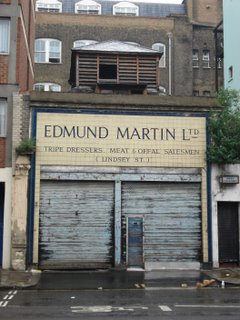 Smithfield markets have long been the meat markets of London (here is the storefront of a tripe and offal establishment) from which restaurants and local butchers buy wholesale. (It was also infamous for the "fires of Smithfield," where unrecanting Protestants were burnt under Mary Tudor.)
Smithfield markets have long been the meat markets of London (here is the storefront of a tripe and offal establishment) from which restaurants and local butchers buy wholesale. (It was also infamous for the "fires of Smithfield," where unrecanting Protestants were burnt under Mary Tudor.)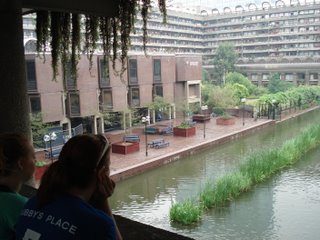 The idea was that upper class and lower class flats would be intermingled (as many streets were in the early modern period). At least at its center (as in this photo), I find it more an ideal than a dystopia, but there are some walkways which are vaguely A Clockwork Orange.
The idea was that upper class and lower class flats would be intermingled (as many streets were in the early modern period). At least at its center (as in this photo), I find it more an ideal than a dystopia, but there are some walkways which are vaguely A Clockwork Orange.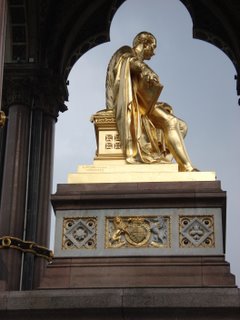 I don;t have much to add about this recently cleaned monument, except to say "what was she thinking!?" Like Barbican, it can be seen as both beautiful and a monstrosity. On our way towards the Memorial in Kensington Gardens, we came to the gates at the end of Exhibitiion Road, which was the place where the Great Exhibition of 1851 (or the Crystal Palace) had been built and opened.
I don;t have much to add about this recently cleaned monument, except to say "what was she thinking!?" Like Barbican, it can be seen as both beautiful and a monstrosity. On our way towards the Memorial in Kensington Gardens, we came to the gates at the end of Exhibitiion Road, which was the place where the Great Exhibition of 1851 (or the Crystal Palace) had been built and opened. 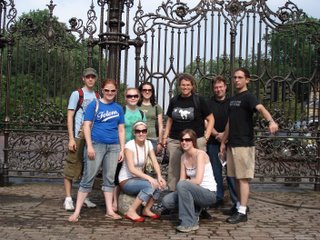 The gates are, of course, the Coalbrookdale Gates, and they are still there (though turned 90 degrees so they don't block the road which now goes through the park dividing Kensington Gardens from Hyde Park) as are (in the photo) Ben, Carrie, Ashley, Krystal, Megan, Amanda, Cassie, Derrick, and Raymond.
The gates are, of course, the Coalbrookdale Gates, and they are still there (though turned 90 degrees so they don't block the road which now goes through the park dividing Kensington Gardens from Hyde Park) as are (in the photo) Ben, Carrie, Ashley, Krystal, Megan, Amanda, Cassie, Derrick, and Raymond.
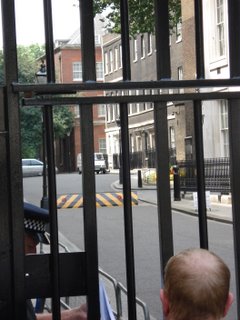 On Tuesday, our first full day in London, we travelled to Westminster, just a short tube ride away from our hotel. The West End is to the west of central London, obviously, the old "mile square" walled city that now houses the nation's (and one of the world's major) financial districts. (The East End is to the, uh, east.) But the West End was also the area towards (and eventually interfilling the area between London and) Westminster.
On Tuesday, our first full day in London, we travelled to Westminster, just a short tube ride away from our hotel. The West End is to the west of central London, obviously, the old "mile square" walled city that now houses the nation's (and one of the world's major) financial districts. (The East End is to the, uh, east.) But the West End was also the area towards (and eventually interfilling the area between London and) Westminster. 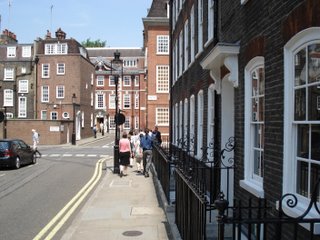
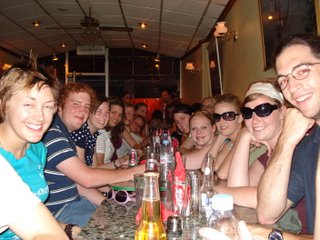
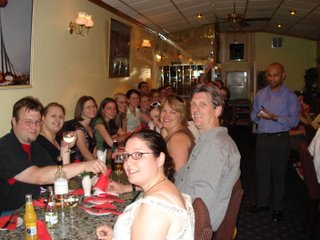 On the walk to the restaurant, you might have noticed the nearby church (on the corner of Fournier St. and Commericial St. , a block off Brick Lane). It was designed by Nicholas Hawksmoor (in the 1710s), a student of Christopher Wren (who had designed St. Paul's and the Emmanuel College Chapel we saw). A block further on is The Jamme Masjid or Great London Mosque on the corner of Brick Lane and Fournier Street.
On the walk to the restaurant, you might have noticed the nearby church (on the corner of Fournier St. and Commericial St. , a block off Brick Lane). It was designed by Nicholas Hawksmoor (in the 1710s), a student of Christopher Wren (who had designed St. Paul's and the Emmanuel College Chapel we saw). A block further on is The Jamme Masjid or Great London Mosque on the corner of Brick Lane and Fournier Street.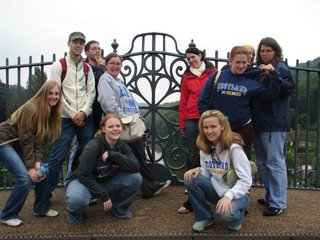
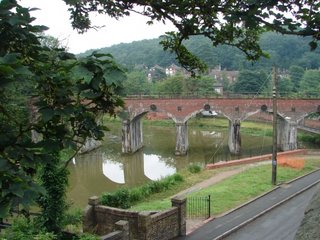 Of course, some of the decorative pieces, like the great gates to the Great Exhibition (Crystal Palace) of 1851 or the iron lamp posts for London, were massive or massive projects. Still, by the mid-19th century, the Darbys sought to market themselves as cast iron artists (and some of the pieces shown in the museums at Ironbridge make iron look like a rare mineral). One of the reasons for the change is that Coalbrookdale and the other places where there were blast furnaces (like Blists Hill) were started because it was a great place to use the river and the canal system to bring in materials (iron ore, coke made from coal, and limestone for the catalyst) from a short distance away. The picture to the right shows a rail bridge crossing the river. The railways were important for the area (iron rails and steam engine boilers were made here and nearby) and also were the undoing of the area (it was too costly to build many railroads in an area cut by rivers, valleys, and canals). One of the reasons that Ironbridge is a World Heritage Site is that there was no modernization after the mid-19th century and much of the place remains as it was during the first Industrial Revolution (or is that Evolution?).
Of course, some of the decorative pieces, like the great gates to the Great Exhibition (Crystal Palace) of 1851 or the iron lamp posts for London, were massive or massive projects. Still, by the mid-19th century, the Darbys sought to market themselves as cast iron artists (and some of the pieces shown in the museums at Ironbridge make iron look like a rare mineral). One of the reasons for the change is that Coalbrookdale and the other places where there were blast furnaces (like Blists Hill) were started because it was a great place to use the river and the canal system to bring in materials (iron ore, coke made from coal, and limestone for the catalyst) from a short distance away. The picture to the right shows a rail bridge crossing the river. The railways were important for the area (iron rails and steam engine boilers were made here and nearby) and also were the undoing of the area (it was too costly to build many railroads in an area cut by rivers, valleys, and canals). One of the reasons that Ironbridge is a World Heritage Site is that there was no modernization after the mid-19th century and much of the place remains as it was during the first Industrial Revolution (or is that Evolution?). 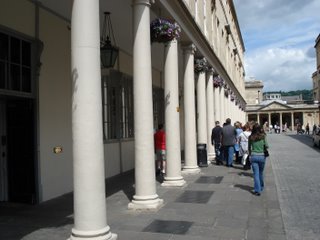
 Thus, Sir Walter wants to be in the best rooms of Camden Place built on the highest hill. But the Royal Crescent, perhaps a built older remains a slightly more prestigious address (seen here to the right). Bath was about mixing the classes, like horse races and gambling spots in London, and exciting place to watch and be watched by others. Moll can meet someone of higher status at the Bath: is it a matter of hiding one's previous status?; or is it that one just doesn't care in Bath (Las Vegas)? Sir Walter separates himself in the highest hill, then spends his time on the street in town watching others of all sorts of ranks.
Thus, Sir Walter wants to be in the best rooms of Camden Place built on the highest hill. But the Royal Crescent, perhaps a built older remains a slightly more prestigious address (seen here to the right). Bath was about mixing the classes, like horse races and gambling spots in London, and exciting place to watch and be watched by others. Moll can meet someone of higher status at the Bath: is it a matter of hiding one's previous status?; or is it that one just doesn't care in Bath (Las Vegas)? Sir Walter separates himself in the highest hill, then spends his time on the street in town watching others of all sorts of ranks.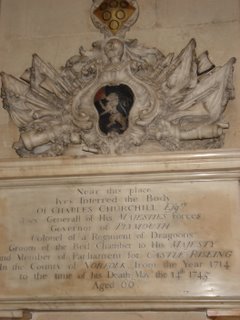 Some tasted the waters, some (me at least) explored the Abbey, did anyone see where Beau Nash lived like I did? The Abbey was chock-full of monuments to departed surgeons, farriers, apothecaries, and military men (as that to the left). Adm. Croft and Capt. Wentworth were fictional characters in Austen's Bath only in name it appears.
Some tasted the waters, some (me at least) explored the Abbey, did anyone see where Beau Nash lived like I did? The Abbey was chock-full of monuments to departed surgeons, farriers, apothecaries, and military men (as that to the left). Adm. Croft and Capt. Wentworth were fictional characters in Austen's Bath only in name it appears.
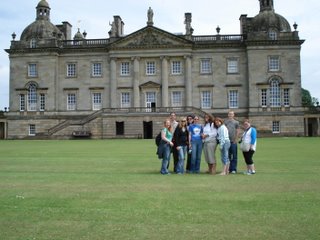 Or should it just state, 'Palladianized'? We visited Houghton and Holkham Halls constructed in the main in the first half of the 18th century last week. Ashley, Ray, Krystal, Megan, Cassie, Amanda, Carrie, Ben, and Kristi can just about be delineated in this picture. I've taught Sir Robert Walpole and I have read quite a bit about Sir Robert, but visiting this pile again (hot and ice water in the dining room?) gives me added insight into the originator of No. 10 Downing Street.
Or should it just state, 'Palladianized'? We visited Houghton and Holkham Halls constructed in the main in the first half of the 18th century last week. Ashley, Ray, Krystal, Megan, Cassie, Amanda, Carrie, Ben, and Kristi can just about be delineated in this picture. I've taught Sir Robert Walpole and I have read quite a bit about Sir Robert, but visiting this pile again (hot and ice water in the dining room?) gives me added insight into the originator of No. 10 Downing Street.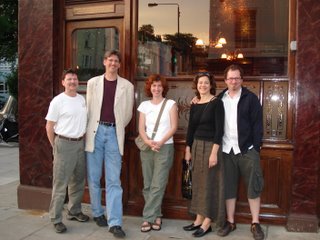
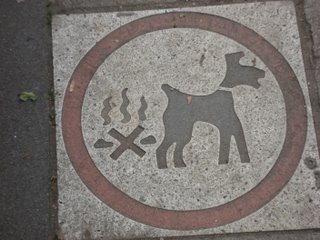 By the way, we need to focus on Hard Times and Cannadine's 19th-century chapter for Monday, and I should have your journals (at least 3 entries per week, and we are now on week 4) by Sunday. I am currently viewing future possible study abroad sites, but will be back Saturday. You may leave same with Dr. Bredesen at dinner Friday night. Got used to having you all around these past two trips and missing you all in Oxford (can that be?).
By the way, we need to focus on Hard Times and Cannadine's 19th-century chapter for Monday, and I should have your journals (at least 3 entries per week, and we are now on week 4) by Sunday. I am currently viewing future possible study abroad sites, but will be back Saturday. You may leave same with Dr. Bredesen at dinner Friday night. Got used to having you all around these past two trips and missing you all in Oxford (can that be?).
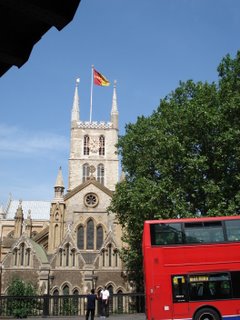
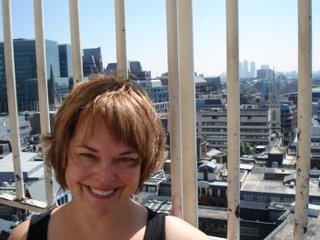 What do professors do on their weekend off? Go to libraries of course. Well, Profs. Newton and Dagni went to London (showing a few of the students how to get signed into the British Library, the Institute of Historical Research, and leaving them with the compatriots at the British Museum). Back to the BL on Saturday, but some time for climbing the Monument commemorating the rebuilding of London after the Great Fire of 1666 (above) and a visit to Southwark (the Cathedral above right) for markets and relaxation (as one might have done in Shakespeare's time). Group will be returning to the Thames on our last week as well.
What do professors do on their weekend off? Go to libraries of course. Well, Profs. Newton and Dagni went to London (showing a few of the students how to get signed into the British Library, the Institute of Historical Research, and leaving them with the compatriots at the British Museum). Back to the BL on Saturday, but some time for climbing the Monument commemorating the rebuilding of London after the Great Fire of 1666 (above) and a visit to Southwark (the Cathedral above right) for markets and relaxation (as one might have done in Shakespeare's time). Group will be returning to the Thames on our last week as well.
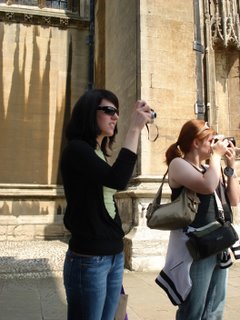 Harlaxtoners Megan and Caroline take pictures of the grass at King's College on which they are not allowed to walk. The first of many steamy, warm days, and our first outing (though the second tour if one includes the tour through Harlaxton by the guides). If class in a 19th-century manor like Harlaxton is denoted by upstairs/downstairs (or, really, the front stairs for the owners and guests, the back stairs for the servants), class in Cambridge was linked to a hierarchical division between scholars, fellows, and masters. Of course, as the quadrangle organization of the colleges (hall, chapel, library, and rooms or dormitory) suggests, the colleges are a guild-like or ordered society like a monastery. "Class" there is more like the estates or orders of the Middle Ages.
Harlaxtoners Megan and Caroline take pictures of the grass at King's College on which they are not allowed to walk. The first of many steamy, warm days, and our first outing (though the second tour if one includes the tour through Harlaxton by the guides). If class in a 19th-century manor like Harlaxton is denoted by upstairs/downstairs (or, really, the front stairs for the owners and guests, the back stairs for the servants), class in Cambridge was linked to a hierarchical division between scholars, fellows, and masters. Of course, as the quadrangle organization of the colleges (hall, chapel, library, and rooms or dormitory) suggests, the colleges are a guild-like or ordered society like a monastery. "Class" there is more like the estates or orders of the Middle Ages.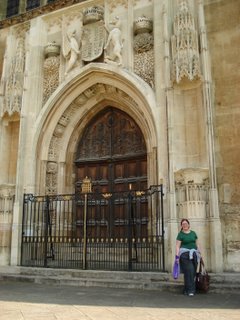
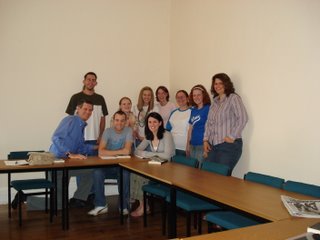
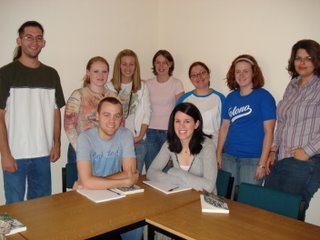 Greetings from Harlaxton.
Greetings from Harlaxton.